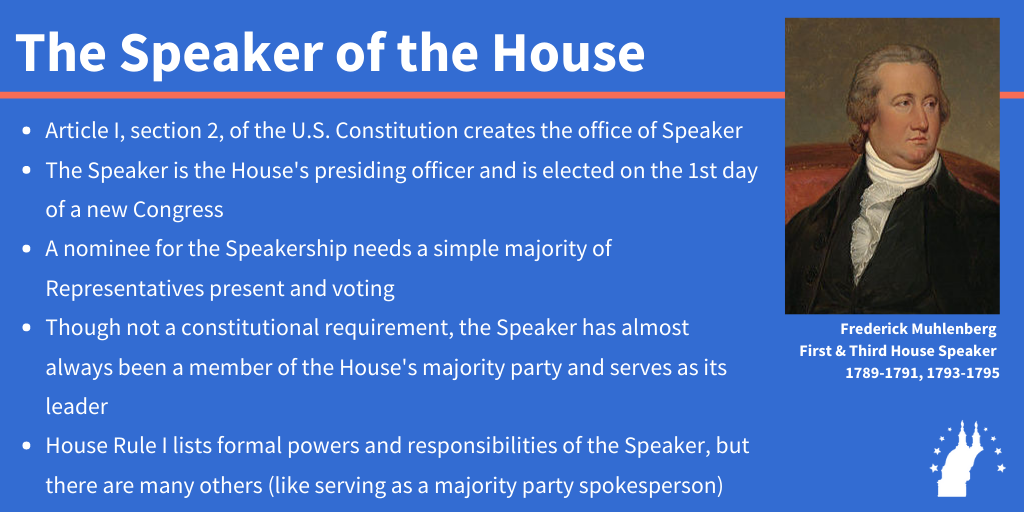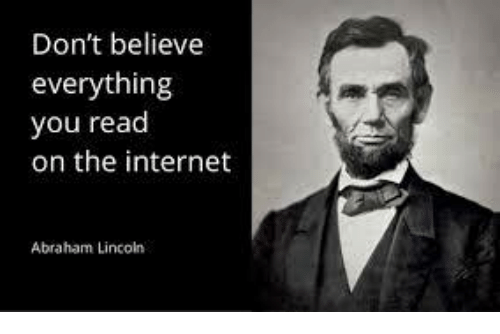
The first day of a new Congress is a truly exciting day for the House, and especially its newly elected Members. One of the most momentous parts of the first day is the constitutional obligation of electing a Speaker, who will preside over the House for the next two years. Since the Speaker has extensive power to set the House’s agenda, they are one of the most powerful people in Washington. The process of electing a Speaker is highly ritualized and generally follows a fairly well-established pattern.
At the end of a Congress, following a general election, the House Republican Conference and the House Democratic Caucus meet separately to prepare for the next Congress. One of the most important acts for each party is to select their leader, who will also be their candidate for Speaker at the convening of the next Congress. Although it is typically obvious who the party leader will be—usually either the current party leader or the next person in the party’s hierarchy—other members can make a bid to lead the party. Displacing a party leader is difficult, but if it appears that an attempt will be successful, the leader may step aside voluntarily. Once a party leader is selected, however, the Members are generally expected to vote for the leader in the vote for the Speakership in the following January.
When the House convenes on the first day of a new Congress, it must first establish that there are enough Members-elect to achieve a quorum, the constitutionally mandated minimum number that must be present to conduct business. The second item of business—even before Members are sworn in—is the election of a Speaker. Until a Speaker is elected, the Clerk from the previous Congress presides over the House. The Clerk calls for nominations for Speakership candidates, and the chairs of the Republican Conference and Democratic Caucus make short speeches on behalf of their parties’ nominees. The Clerk then asks for any other nominations to be brought forward. Then the Clerk appoints tellers from among the Members-elect to record the votes, and the voting begins. Each Member-elect has the opportunity to vote when the Clerk calls his or her name. Typically, the Member-elect responds by calling out the last name of the person they wish to be Speaker. They may also answer “present,” a response that does not count as a vote for anyone but does contribute to a quorum. Or they could decline to respond at all, in which case they would be considered not voting. (The forgoing is a description of what usually occurs at the beginning of a Congress. Extraordinary circumstances may vary these proceedings. An extensive treatment of the process of electing a Speaker, including information about unusual events, is available in the Precedents of the United States House of Representatives.)
The vote for Speaker is a rare instance where a verbal roll call is made of each Member. The House usually records its votes by electronic means, which saves a lot of time and allows Members to vote at any time during the 15-17 minutes usually reserved for a roll call. But the Speaker’s election is different, partly by tradition, but also because it is not a yes or no vote. In 2017, the Speakership vote took well over an hour.
To win the Speakership, a person must secure a simple majority of those present and voting. If all 435 Representatives-elect vote for a particular person, the majority would be 218. For each person who answers present or otherwise does not vote, the threshold to win a majority decreases. In effect, the threshold decreases by a vote for every two people who answer present or do not participate.

Find this interesting? You might also like “Busting Congressional Myths.”
By long tradition, each Member votes for their party’s nominee. In fact, the rules for the House Democratic Caucus for the 115th Congress specifies that “a majority vote of those present and voting at a Democratic Caucus shall bind all Members of the Caucus” in the vote for Speaker and other House officers (Rule 34(A), in Compilation of Selected Rules of the Republican Conference and Democratic Caucus, Committee Print RCP 115-37). Historically, this expectation has been so strong that a person will vote for their party leader even if they opposed the nominee during their party’s organizing meetings held in the previous fall after the election. For instance, in the lead up to the 1971 Speakership contest, Representative John Conyers challenged Majority Leader Carl Albert, the presumptive Democratic nominee, during the party meeting. On the Floor, however, Conyers voted for Albert (Congressional Record, January 21, 1971, p. 11). Even when a Member later decides to switch parties mid-Congress, it has been common for them to vote for their party’s nominee. The most notable example of this is Representative Phil Gramm who voted for fellow Democrat Tip O’Neill for Speaker on January 3, 1983 (Congressional Record, January 3, 1983, p. 30). A mere two days later, Gramm resigned so he could run to succeed himself as a Republican (a race he won the following month). On occasion, party members answered “present.” For instance, Representative Ralph Hall, then a Democrat, answered “present” in the 1985 Speakership election, but did not do so in previous or subsequent votes (Congressional Record, January 3, 1985, p. 379). It is exceptionally rare for a Member-elect to vote for the other party’s candidate. The last to do so was the colorful, late Jim Traficant, a Democrat from Ohio, who voted for Speaker J. Dennis “Denny” Hastert in 2001. The Democrats responded by refusing to assign him to any committees, making him the first rank-and-file Member without committee assignments in almost 100 years.
Since the 105th Congress, the practice of voting for the party’s nominee has been weakened somewhat. When the House convened for the 105th Congress on January 7, 1997, rather than vote for Newt Gingrich, who was facing ethics problems at the time, five Republicans answered present and four others voted for other candidates. After that election, votes for candidates other than the official party nominee decreased until the 112th Congress. In the 112th Congress, the Republicans took control of the House again after being out of power since 2007. On January 5, 2011, 18 Democrats, frustrated with Nancy Pelosi’s leadership, voted for other candidates and an additional Democrat answered present. The following Congress, the 113th, both parties had dissenters. Eight Republicans voted for different candidates, as did five Democrats; an additional Republican answered “present.” At the convening of the 114th Congress, 24 Republicans and 4 Democrats voted for different candidates and 1 Republican answered present. In that election, John Boehner was elected with 216 votes because several Democrats were delayed (some think deliberately) in returning to the Chamber after the funeral of former New York Governor Mario Cuomo. The 115th Congress was more typical than the past few Congresses: Only one Republican voted for a different candidate, as did four Democrats. While these defections in recent Congresses are only a small minority of each party, they do mean that it is common for journalists and pundits to speculate on whether the majority-party nominee will have enough votes to become Speaker. This year, the margin of error for winning has been so small that Democratic Leader Nancy Pelosi has vigorously negotiated with her fellow party members to ensure that she has enough votes to win in January.
And while we’re talking about Members-elect answering present: One practice that seems to be declining is that of nominees for the Speakership answering present when the Clerk calls upon them to cast their votes. In 2005, Hastert became the last of the official Republican or Democratic candidates to answer present. Since then, the Democratic candidate has been Nancy Pelosi and the Republican candidates have been John Boehner and Paul Ryan. Pelosi’s consistent practice has been to vote for herself (both when she was elected Speaker and the defeated candidate). In 2007, Boehner voted for himself (when he was defeated). In subsequent elections, rather than answer “present,” he did not participate in the vote. Paul Ryan did not vote in either of his two elections (both successful). Some protest candidates have also voted for themselves: Heath Shuler, a Democrat, in 2011 and Daniel Webster and Ted Yoho, both Republicans, in 2015.
With the opening of the 116th Congress quickly approaching, the House will soon elect a new Speaker—most likely Nancy Pelosi of California. May the Speaker preside with fairness, integrity and a genuine love for the House and all its Members, regardless of their party.
Want to learn more about Congress? Sign up for the Congressional Institute’s e-newsletter!